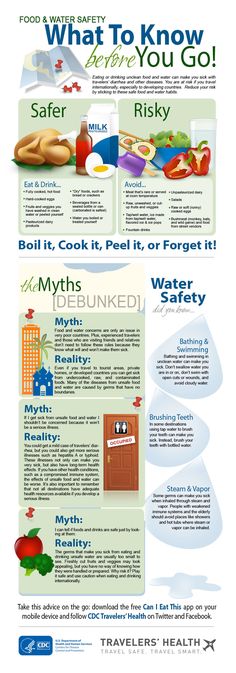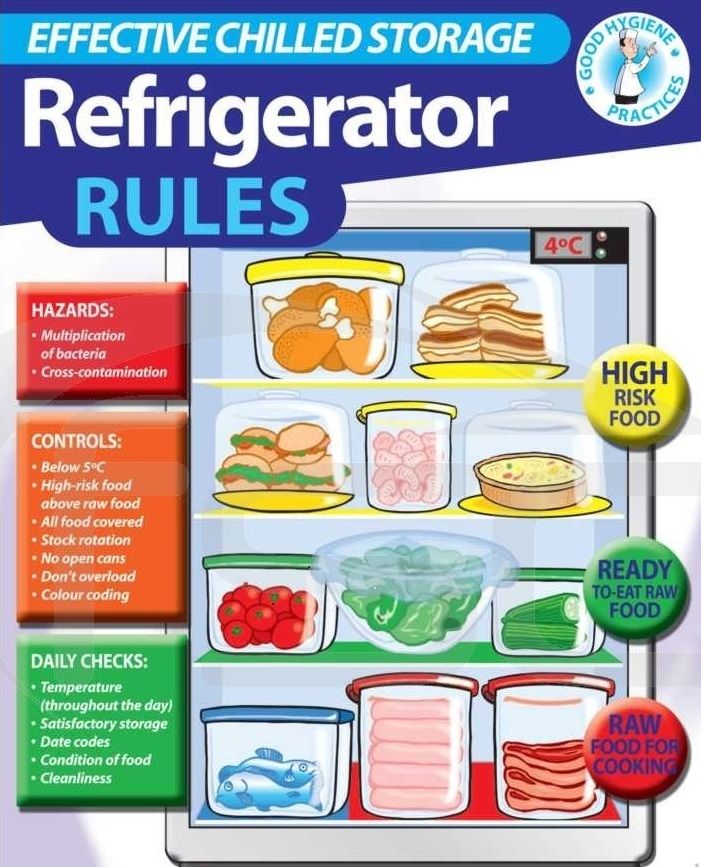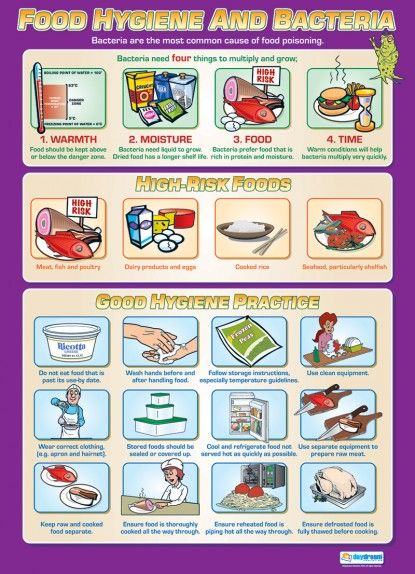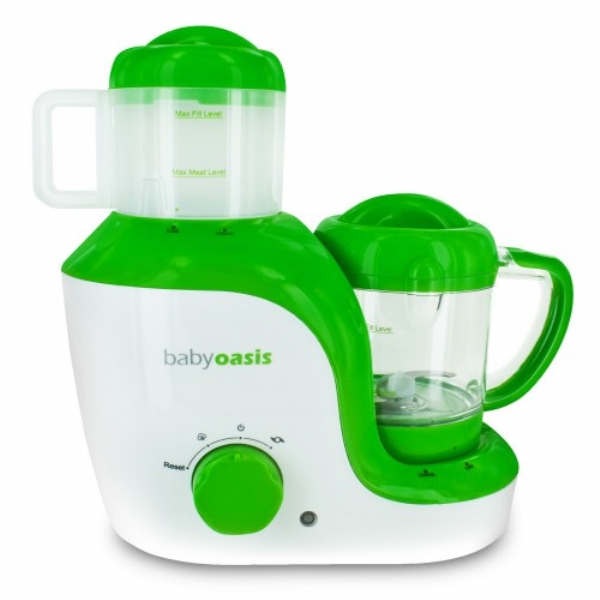Food safety for babies
People at Risk: Children Under Five
Image
Download full-resolution infographic
Children younger than five years are at an increased risk for foodborne illness and related health complications because their immune systems are still developing. Young children with developing immune systems cannot fight off infections as well as adults. In addition, young children produce less stomach acid that kills harmful bacteria, making it easier for them to get sick.
Foodborne illness (also called food poisoning) can be particularly dangerous for young children because it often causes vomiting or diarrhea or both. Since children's bodies are small, they can quickly lose a lot of body fluid and become dehydrated.
Food safety for young children depends on the food safety behaviors of their parents and caregivers. Handwashing is especially important. Children and those caring for them should wash hands often, especially before, during and after preparing food and before eating.
In children under 5 years old, E. coli infections are more likely to lead to hemolytic uremic syndrome (HUS), a severe complication that can cause chronic kidney disease, kidney failure and death.
Symptoms of HUS are:
- Urinating less often
- Feeling very tired
- Losing pink color in cheeks and inside the lower eyelids
These new symptoms usually develop after about a week of E. coli illness, when the diarrhea is improving.
Choose and Prepare Safe Food
Learn about safer food choices for people with a higher risk for foodborne illness, including young children. If you prepare food for children under the age of five, you should always follow these four steps:
Clean: Wash hands, utensils and surfaces often. Germs can spread and survive in many places.
Separate: Raw meat, poultry, seafood, and eggs can spread illness-causing bacteria to ready-to-eat foods, so keep them separate.
Cook: Food is safely cooked only when the internal temperature is high enough to kill germs that can make you sick. See the safe minimum cooking temperatures chart for how to safely prepare meat, seafood, chicken, and other foods.
Chill: Refrigerate perishable food promptly. Bacteria that cause food poisoning multiply quickest between 40°F and 140°F.
Safe Storage of Puréed and Solid Baby Food
Download Table as PDF
| Purees and Solids (opened or freshly made) | Refrigerator | Freezer |
|---|---|---|
| Strained fruits and vegetables | 2 to 3 days | 6 to 8 months |
| Strained meats and eggs | 1 day | 1 to 2 months |
| Meat/vegetable combinations | 1 to 2 days | 1 to 2 months |
| Homemade baby foods | 1 to 2 days | 1 to 2 months |
Safe Microwaving of Puréed and Solid Baby Foods
Follow these precautions when microwaving baby food:
- Don't microwave baby foods in the jar.
 Instead, transfer the food to a dish before microwaving it. This way the food can be stirred and taste-tested for temperature.
Instead, transfer the food to a dish before microwaving it. This way the food can be stirred and taste-tested for temperature. - Microwave four ounces of solid food in a dish for about 15 seconds on high power. Always stir, let stand 30 seconds, and taste-test before feeding. Food that's "baby-ready" should taste or feel lukewarm.
- Don't heat baby-food meats, meat sticks, or eggs in the microwave. Use the stovetop instead. These foods have a high fat content, and since microwaves heat fats faster than other substances, these foods can cause splattering and overheating.
Safe Preparation and Storage of Infant Formula
How to Prepare Formula
- Carefully read and follow the instructions on the infant formula container.
- Wash your hands well before preparing bottles or feeding your baby.
- Clean and sanitize the workspace where you will prepare the infant formula.
- Use clean, sanitized bottles. Learn how to clean, sanitize, and store infant feeding items.

- If you use powdered infant formula, use water from a safe source to mix it. If you are not sure if your tap water is safe to use for preparing infant formula, contact your local health department.
- Use the amount of water listed on the instructions of the infant formula container. Always measure the water first and then add the powder.
- If your baby is younger than 3 months old, was born prematurely, or has a weakened immune system, you may want to take extra precautions in preparing your infant’s formula to protect against Cronobacter, a rare but serious infection that can be caused by germs in powdered infant formula.
- Use prepared infant formula within 2 hours of preparation and within 1 hour from when feeding begins.
- If you do not start to use it within 2 hours, immediately store the bottle in the fridge and use it within 24 hours.
- Throw away formula left in the bottle after feeding your baby.
Heating Breast Milk or Formula
Baby’s milk or infant formula does not need to be warmed before feeding, but some people like to warm their baby’s bottle. If you do decide to warm the bottle, here is advice on how to warm it safely:
If you do decide to warm the bottle, here is advice on how to warm it safely:
In Hot Tap Water: Place bottle under hot, running tap water until the bottle reaches the desired temperature. This should take 1 to 2 minutes.
On the Stove: Heat water in a pan. Remove the pan from the heat and set the bottle in the hot water until the bottle is warm.
When heating baby's milk, always shake the liquid to even out the temperature and test on top of your hand—not the wrist (this is one of the areas least sensitive to heat)—before feeding. Milk that's "baby-ready" should feel lukewarm.
Never heat breast milk or infant formula in the microwave. Microwaves heat baby's milk and formula unevenly, which results in hot spots that can burn a baby's mouth and throat.
Check out this guide to help you, grandparents, and caregivers keep your baby’s food safe: Once Baby Arrives, from Food Safety for Moms to Be.
Food safety for babies and toddlers
Read time: 3 minutes
What to know about feeding your baby and toddler safelyImportance of food safety for babies and toddlers
Preventing foodborne illness
Other food safety considerations
Babies and toddlers are particularly vulnerable to foodborne illness because their immune systems are not yet fully developed. 1 Because of this, it can be harder for your baby to fight off an infection and it may even take them longer to get well. To help reduce their risk of getting sick, it is imperative to follow proper food safety techniques.
1 Because of this, it can be harder for your baby to fight off an infection and it may even take them longer to get well. To help reduce their risk of getting sick, it is imperative to follow proper food safety techniques.
Read on to learn the best food safety practices to help keep your baby and toddler safe while eating.
Helping prevent foodborne illnessThere are many ways to help prevent foodborne illness in babies and toddlers including:
Good hygiene: Hand washing, as well as adequate washing of all utensils and surfaces, is the most effective measure you can take in preventing foodborne illness in your baby or toddler.1
This includes proper cleaning and sterilization of bottles, sippy cups, breast pump parts, and other baby feeding supplies.
Avoiding higher-risk foods: Certain foods are more susceptible to bacterial growth and should not be given to your child. These include:
These include:
Unpasteurized dairy products, including milk and cheese
Raw and undercooked eggs and foods containing raw or undercooked eggs
Raw and undercooked meat and poultry
Raw and undercooked fish and shellfish
Unpasteurized juices (unless freshly squeezed yourself)
Raw sprouts
Honey: do not give to children less than 12 months old due to the risk of botulism, a foodborne illness2,3,4
Appropriate handing and storing of breastmilk and formula. Proper handling, storage and reheating of breastmilk, as well as proper handling and preparation of formula are critical to help prevent bacterial growth.5,6,7
Read more:
Safe Storage of Pumped Breastmilk
Everything You Need to Know about How to Prepare and Store Infant Formula
Other Food Safety ConsiderationsChoking: Babies and toddlers are at an increased risk of choking, so it’s important to provide age-appropriate textures and suitably sized foods. 8
8
Depending on what stage of eating your child is at, make sure that any food you provide is either pureed, mashed, or a pea-sized (or thin strip) soft solid that is ‘smushable’ between your fingers.9 Once your toddler gets a little older and better at chewing and swallowing, firmer textures may be handled.
Learn about:
Preventing Choking in Infants and Toddlers
Introducing Solids: First Foods and Textures
Mercury: Fish is a great source of lean protein, and many fattier fish also have beneficial omega-3 fatty acids. However, certain types of seafood have a high mercury content, which may affect your child’s developing nervous system.10
Higher mercury fish include: Canned albacore tuna, bigeye tuna, swordfish, King mackerel, shark, and tilefish.11
Lower mercury fish include: Salmon, cod, anchovy, sardines, haddock, scallop, freshwater trout, canned chunk light tuna, pollock, tilapia, and catfish. 11
11
For families who eat meat, the US Food and Drug Administration recommends eating low mercury fish 2 to 3 times per week as part of a balanced diet. For more information on mercury in seafood, please see these FDA recommended guidelines.11
Tips on safely feeding your infant and toddlerCook foods thoroughlyCook foods, such as meats, poultry, and fish, to recommended internal temperatures to ensure harmful bacteria are killed.
Safe minimum cooking temperatures:
Cuts of beef, pork, veal, and lamb: 145 degrees
Ground meats: 160 degrees
Poultry: 165 degrees
Fish and shellfish: 145 degrees12
Learn about: How Can I Make my own Pureed Baby Food?
Don’t “double dip”Feeding your baby straight from the jar can introduce bacteria from your baby’s mouth from the spoon into the food. Instead, spoon a small amount into a bowl and feed your baby from there. Throw out any food from the bowl that your baby did not eat.3
Instead, spoon a small amount into a bowl and feed your baby from there. Throw out any food from the bowl that your baby did not eat.3
If using a pouch, squeeze the amount you’d like to feed your baby into a bowl, or squeeze a small amount onto a spoon. Feed from the bowl or spoon, making sure not to touch the tip of the pouch spout to the spoon, which would introduce bacteria to the pouch.
You can place whatever is left in the jar or pouch (that did not come into contact with your baby’s saliva) back in the refrigerator for later use.3 Most manufacturers say these leftovers can be kept for 1 to 2 days in the refrigerator before needing to be thrown out.
Read more: How to Store Baby Food
Timing is keyBe familiar with the recommended “safe times” for opened jarred and pouch baby food:
Opened, strained fruits or veggies: 2 to 3 days
Strained meats and eggs: 1 day
Veggie and meat combinations: 1 to 2 days
Homemade baby foods: 1 to 2 days1
Be sure to wash bottles, sippy cups, feeding utensils, breast pump parts and other feeding supplies in hot, soapy water then rinse thoroughly.
Learn about: How to Properly Clean your Breast Pump
Follow proper handling and preparation of infant formulaMix formula with safe water source
Prepared formula must be discarded within 1 hour after feeding your baby
Prepared formula that has not been given to baby can be stored in the refrigerator for up to 24 hours
An open container of ready to feed or concentrated formula should be covered, refrigerated, and discarded after 48 hours if not used
Read more:
Formula Preparation: What Type of Water Should I Use?
Everything You Need to Know About How to Prepare and Store Infant Formula
Help prevent chokingTake these precautions to minimize the risk of your child choking:
Foods that pose a risk of choking should be avoided. Examples include nuts, whole grapes, hot dogs, raw carrots, raisins, popcorn, and portions of food that are too large.

Stay close to your baby during meals to make sure they are tolerating foods appropriately
Make sure your baby or toddler is in a designated feeding chair like a highchair or booster seat
Allow baby to eat at their own, comfortable pace8,13
If you can’t remember whether the leftovers are from two days ago or last week, throw it out.
Let's Chat!We know parenting often means sleepless nights, stressful days, and countless questions and confusion, and we want to support you in your feeding journey and beyond.
Our Happy Baby Experts are a team of lactation consultants and registered dietitians certified in infant and maternal nutrition – and they’re all moms, too, which means they’ve been there and seen that. They’re here to help on our free, live chat platform Monday - Friday 8am - 6pm (ET), and Saturday - Sunday 8am - 2pm (ET). Chat Now!
Chat Now!
Read more about the experts that help write our content!
For more on this topic, check out the following articles:How to Choose the Right Breast Pump
How much Formula does my Baby Need?
What to Know about Traveling with Infant Formula
Sources
Food Safety Together
When a patient's immune system is weakened by cancer and its treatment, the body has a harder time fighting bacteria, parasites, or viruses that may be in food. Microorganisms found in food and drink sometimes cause diseases or infections in the gastrointestinal (GI) tract. They are called intestinal infections or food poisoning.
Signs of an intestinal infection
Usually, the symptoms of an intestinal infection are similar to indigestion. It is characterized by:
- Diarrhea
- Abdominal pain or cramps
- Nausea and vomiting
- Heat
- Chills
- Headache
- Muscle pain and weakness
Most people begin to feel ill in the first few days after infection. However, sometimes an intestinal infection develops within a few hours, or, conversely, symptoms may not appear for a week or more.
However, sometimes an intestinal infection develops within a few hours, or, conversely, symptoms may not appear for a week or more.
If intestinal infection is suspected:
- Tell your doctor.
- Drink plenty of fluids.
- If possible, save suspect food and packaging. Doctors may ask them for research.
- If you suspect that poor-quality food was served to you in a restaurant or other public place, contact Rospotrebnadzor by phone at 8-800-555-49-43. This will help you prevent poisoning other people.
Always wash your hands before and after preparing food.
Prevention of intestinal infections
Compliance with simple rules will help prevent the development of intestinal infections. This is especially important for patients with low immunity. Doctors can tell you about other hygiene rules that you need to follow while preparing and eating food.
Ways to prevent intestinal infections:
- Handle food properly.

- Avoid cross contamination.
- Prepare food thoroughly.
- Be mindful of your purchases.
- Take precautions when eating in public places.
Proper food handling
Proper food handling helps reduce the chance of intestinal infection. Often the cause of gastrointestinal disorders is that the products were not washed thoroughly or stored incorrectly.
- Wash hands with warm soapy water.
- Wash your hands both before and after preparing food.
- Always wash your hands before eating.
- Maintain the correct temperature.
- Hot food must be hotter than 60°C and cold food colder than 4°C. Do not leave food at room temperature for more than 1 hour.
- Meat, fish or poultry should be thawed in the microwave or refrigerator. Place them on the tray so that the liquid does not spread.
- Thawed food must be used immediately, re-freezing is not allowed.
- Perishable food should be refrigerated no later than 2 hours after purchase or preparation.

- Wash fruit or vegetables before peeling and cutting.
- Rinse leafy vegetables under running water, one leaf at a time.
- Rinse off dirt with a clean sponge.
- Wash all packaged greens and other prepared foods labeled "washed".
- Do not eat vegetables if they are:
- Muddy or moldy.
- Were pre-cut at the store.
- Additional Rules:
- Wash cans with soap and water before opening.
- Do not eat raw plant sprouts.
- Never taste food with a spoon, fork or spatula, which you will then use again for stirring or layering.
- Discard cracked eggs.
- Do not eat food that looks or smells suspicious.
Prevention of cross-contamination
Bacteria from raw food can easily spread to other foods and kitchen surfaces. Simple ways to keep your kitchen hygienic:
- Keep dishes, countertops and cutting boards clean.

- Cut each type of food separately with a clean knife.
- Wash tables and kitchen boards with hot soapy water or a fresh solution of 1 part bleach to 10 parts water.
- Use food-grade wet wipes.
- Keep miscellaneous foods separate.
- Keep raw meat in a sealed container or container and keep it away from other cooked foods in the refrigerator.
- Arrange foods on the kitchen counter so that they do not touch.
- Use separate boards for slicing meat, fruits and vegetables.
- When grilling meat, place the cooked pieces on a clean plate.
Thorough cooking
Cooking food, especially meat and poultry, at the right temperature reduces the chance of gastrointestinal upset.
- Use a meat thermometer. Insert the thermometer into the middle of the thickest piece of meat.
- Cook meat at 75°C.
- Cook poultry at 85°C.
- Cook the meat until the pink color disappears.

- Meat juice must be clear.
When cooking in the microwave, make sure that there are no cold areas where live bacteria can remain.
- Turn food over while cooking.
- Reheat leftovers covered with a lid or in a plastic bag with a hole for the hot air to escape.
- Stir food frequently.
Conscious shopping
Intestinal infection prevention starts in the store.
- Check the expiration date. Don't buy expired items.
- Choose only fresh produce. Pay attention to:
- Packing dates for raw meat, poultry and seafood
- Labeling on fruits and vegetables
- Sealed prepackaged products
- Do not buy or eat:
- Cans in damaged, rusty, swollen or dented cans
- Sliced products
- Unchilled desserts or pastries with whipped cream and custard
- Food in the self-service section or in the cookery
- Soft ice cream or yoghurt ice cream
- Products at free tastings
- Broken or unchilled eggs
- Additional shopping tips:
- Frozen and chilled products should be taken immediately before going to the checkout, especially in hot weather.

- Refrigerate food as soon as you return from the store.
- Frozen and chilled products should be taken immediately before going to the checkout, especially in hot weather.
Food Safety in Public Places
Eating out often comes with additional challenges because you know less about how the food was prepared and stored. But you can take steps to reduce the risk of gastrointestinal upset when eating in a restaurant.
- Check the rating of the restaurant according to the sanitary inspection. This will help you understand how carefully the restaurant complies with food safety rules and requirements.
- Talk to the waiter. Explain your special needs to him in advance.
- Ask that everything be prepared fresh for you.
- Ask for spices and seasonings to be in separate single packs.
- Drink only pasteurized fruit juices - this reduces the number of bacteria.
- Ask for the meat to be well-done.
- Avoid certain foods.
- Avoid eating at convenience stores, salad bars, or buffets.

- Limit your intake of raw fruits and vegetables.
- Do not order fresh juices.
- Avoid eating at convenience stores, salad bars, or buffets.
- Additional tips for eating in public places:
- Be sure to place utensils on a napkin, clean tablecloth or coaster, not on the table. Otherwise, ask for new appliances.
- For uneaten food, ask for a package and re-swap it yourself.
- Place leftovers from the restaurant in the refrigerator immediately.
Food safety in hospital ward
- Wash your hands before and after eating.
- Remove opened or perishable food after one hour as bacteria can grow in it.
- Dispose of food in the designated waste bin.
- Do not store food in the child's room. Use a designated refrigerator.
- Write the child's name and placement date on the food you put in the refrigerator.
More Information
For more information, visit the FDA Food Safety for People with Cancer page on the US Food and Drug Administration website.
Learn more about food safety in cleaning, serving, preparing and cooling.
-
Modified June 2018
Various food groups in the diet of infants and young children
Vegetables and fruits
Vegetables and fruits are an extremely important source of vitamins and minerals, so they must be on the baby's menu. Vegetables are great as first foods. For example, carrots contain natural sugar and the sweet taste of this vegetable is very popular with children, but at the same time, carrots contain a high amount of beta-carotene and other essential nutrients. Beans and other legumes are high in folate, but because of so-called anti-nutrients and the danger of choking, they are not suitable as first foods. If you still give them to children, then in a limited amount and in pureed form.
Fresh and firm vegetables are difficult for the child to eat. Vegetables and fruits can be served steamed, baked, pounded or chopped right before eating. In fresh form, the child can be given, for example, bananas, mangoes or other fairly soft fruits.
In fresh form, the child can be given, for example, bananas, mangoes or other fairly soft fruits.
In addition, vegetables, fruits and berries can be mashed, both fresh and pre-boiled. To ensure food safety, all pre-frozen foods must be thoroughly reheated before eating. Individual vegetables and fruits contain very different amounts of nutrients, so the child's menu should contain different types of fruits.
Since babies need vegetables, it is worth increasing their number in the diet of the rest of the family. Vegetables can be "hidden" in almost every dish. Fresh tomatoes and carrots, for example, are perfect with meat sauces and simple pastas.
Cereals, potatoes and bread
Depending on the country and culture, potatoes, rice, baked goods and pasta form an essential part of the daily menu. They are also necessary for babies, but compared to the diet of an adult, a children's table should contain significantly less of these products. Vegetables and fruits are more necessary for babies. Grains are still rich in many nutrients, such as B vitamins, fiber and minerals. We recommend that you try to offer your child, including, and not the most common cereals, such as quinoa or millet.
Vegetables and fruits are more necessary for babies. Grains are still rich in many nutrients, such as B vitamins, fiber and minerals. We recommend that you try to offer your child, including, and not the most common cereals, such as quinoa or millet.
Whole grains contain anti-nutrients that interfere with the absorption of nutrients. In order to absorb the necessary nutrients in sufficient quantities, children should not be given large amounts of whole grains.
Although milk is a good source of calcium, it is recommended to use milk and water in a one-to-one ratio when making porridge for babies, as cow's milk interferes with the absorption of iron. To prepare cereals for children under one year old, you can use a partially adapted milk formula, and if the child receives breast milk in sufficient quantities, then a partially adapted mixture in half with water. NB! Milk mixtures cannot be boiled, first you need to boil the porridge in water and add the mixture only at the end of cooking. To increase the content of vitamins in porridge, you can add grated berries or fruits to it.
To increase the content of vitamins in porridge, you can add grated berries or fruits to it.
Milk and dairy products
During the first six months of life, the child should be fed exclusively with breast milk. Children over 6 months of age can drink additional pure water if they are thirsty. Upon reaching the age of six months, when, in addition to breast milk, the child is able to digest more complex foods, it is allowed to prepare complementary foods (for example, porridge) in addition to breast milk, you can add a small amount of pure or mixed with water cow's milk. Dairy products are a good source of calcium and vitamin B 12 .
Added fat
Breast milk is very rich in fat, so the baby is used to getting most of its energy from fat. During the period when the baby begins to get acquainted with new foods, most of the energy should also come from fat, at least during the first two years. With continued breastfeeding, most of the baby's fat needs are covered by breast milk. In the event that the child no longer receives a breast, you can add butter or vegetable oil to his food (for example, in porridge or vegetable puree), at the rate of approximately 5 grams of fat per 100 grams of food.
In the event that the child no longer receives a breast, you can add butter or vegetable oil to his food (for example, in porridge or vegetable puree), at the rate of approximately 5 grams of fat per 100 grams of food.
Fats are made up of a variety of fatty acids that are vital for a child's rapidly developing brain and nervous system. The baby receives most of them mainly from breast milk, and later from fish, vegetable oils, for example, from linseed or rapeseed.
Nuts and seeds are also a good source of unsaturated fatty acids, but during the first year of life their intake should be severely limited as they are also high in phytates. These are substances that interfere with the absorption of other essential nutrients. To reduce the amount of phytates, nuts should be soaked for at least 8 hours before being added to infant food. It is worth remembering that eating nuts in general can be dangerous for the baby. They can be inhaled and cause suffocation!
Do not give your child deep-fried foods such as french fries or donuts. Store-bought cookies are also high in fat and are not suitable for a baby to eat.
Store-bought cookies are also high in fat and are not suitable for a baby to eat.
Meat products, chicken, fish, eggs
Compared to older children and adults, protein foods are much more limited in young children. Therefore, you should not worry too much about whether the child is getting enough protein. A normal and balanced diet provides this need.
However, protein-rich food contains a lot of other important nutrients, so you should not limit your child's diet, it is necessary to provide the child with a varied and rich menu.
Red meat is high in iron and fish is high in essential fatty acids. When cooking for a baby, the meat needs to be cooked much longer so that it becomes as soft as possible, and it is easier to grind it into a puree.
Fish is a good and nutritious part of many dishes. Be sure to make sure that all bones are removed, even the smallest ones.
A small amount of boiled egg can be added to any dish offered to the baby. The egg can be cut into small pieces and let the baby try to eat it on his own, with his hands. In addition, the egg can be introduced into the child's menu as part of, for example, casseroles.
The egg can be cut into small pieces and let the baby try to eat it on his own, with his hands. In addition, the egg can be introduced into the child's menu as part of, for example, casseroles.
Human cells need sodium. It is a mineral found mainly in salt, so people should get some of it from their diet. A person receives a sufficient amount of sodium even when we do not salt our food. Baby food should not be salted at all.
Sugary foods and snacks such as sodas, fruit drinks, sweets, ice cream, cookies, cakes and other sweets do not contain vitamins and minerals, or if they do, they contain negligible amounts. At an early stage of development, the child needs a large amount of vitamins and minerals. Foods that are high in sugar, including sweet yogurt and cottage cheese, even in small amounts, spoil a child's appetite and provoke further refusal of a child to eat healthy, nutrient-rich foods. A child's habit of eating sugary foods every day can increase the risk of obesity.










